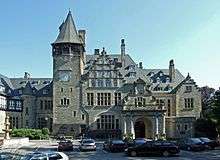Schlosshotel Kronberg
Schlosshotel Kronberg (Castle Hotel Kronberg) in Kronberg im Taunus, Hesse, near Frankfurt am Main, was built between 1889 and 1893 for the dowager German Empress Victoria and originally named Schloss Friedrichshof in honour of her late husband, Emperor Frederick III (Friedrich III). The principal architect was Ernst von Ihne, who was also the royal architect to Frederick III and Kaiser Wilhelm II; von Ihne designed many royal residences for nobility in and around Germany and Austria.


.jpg)
Today the castle is a five-star hotel[1] which belongs, together with the accompanying park, to the House of Hesse. Parts of the original furnishings as well as pieces of art from the collection of the empress are still present in the hotel, along with her extensive library. The grounds contain an 18-hole golf course, designed by Dwight D. Eisenhower, and a public town park.
History
The Empress spent most of her time at the castle until her death in 1901 when the castle, with its entire contents, art collection and the Empress's correspondence, were inherited by the Empress's youngest daughter, Princess Margaret of Prussia, Landgravine of Hesse.
World War II and post-war looting
After World War II, Friedrichshof was used as an officer's club by the military authorities during the American occupation.
Princess Margaret's son Wolfgang, fearing for the family jewels, had buried them in a zinc-lined box in the subcellar of the castle.[2] On 5 November 1945, the manager of the club, Captain Kathleen Nash, discovered the jewels and together with her future husband, Colonel Jack Durant, and Major David Watson, stole the treasure and took the jewels out of Germany.[2] Many of the pieces were broken up and the gems sold separately, ruining the priceless heirlooms of the ancient House of Hesse. In early 1946, Princess Margaret discovered the theft when the family wanted to use the jewels for the wedding of Princess Sophia who was preparing to remarry. Princess Sophia and Landgravine Margaret denounced it to the Frankfurt authorities; the culprits were imprisoned in August 1951. Major Watson was sentenced to three years, but paroled early. Captain Nash was sentenced to five years and Colonel Durant was sentenced to fifteen years. Only 10 percent of what had been stolen was recovered and returned to the Hesse family.[2]
Author Charles Higham claimed that Anthony Blunt, an MI5 agent and Soviet spy, acting on orders from the British royal family, made a successful secret trip to Schloss Friedrichshof towards the end of the war to retrieve sensitive letters between the Duke of Windsor and Adolf Hitler and other leading Nazis.[3] What is certain is that George VI sent the Royal Librarian, Owen Morshead, accompanied by Blunt, then working part-time in the Royal Library as well as for British intelligence, to Friedrichshof in March 1945 to secure papers relating to the German Empress Victoria, the eldest child of Queen Victoria. The papers rescued by Morshead and Blunt, and those returned by the American authorities from Chicago, were deposited in the Royal Archives.[4]
Fire
The building suffered from a fire in 1967.[1]
See also
References
- Jana Randow and Piotr Skolimowski (2019-11-14). "Christine Lagarde Musters ECB Team for Huddle at Castle Fit for an Empress". Bloomberg.CS1 maint: uses authors parameter (link)
- Petropoulos, Jonathan, Royals and the Reich, Oxford University Press, New York, 2006, pp. 344-349. ISBN 0-19-516133-5
- Higham, Charles (1988), The Duchess of Windsor: The Secret Life, New York: McGraw-Hill Publishers, pp. 388–389
- Bradford, Sarah (1989), The Reluctant King: The Life and Reign of George VI, New York: St Martin's, p. 426
External links

- Official website: